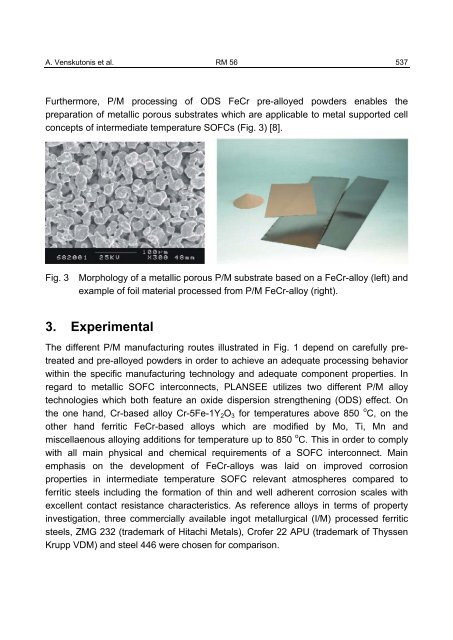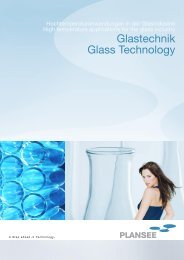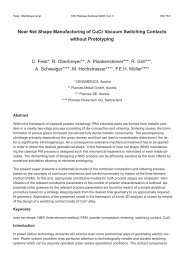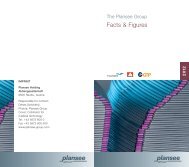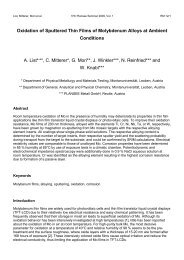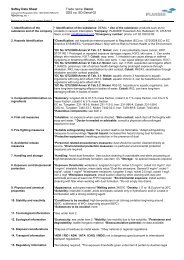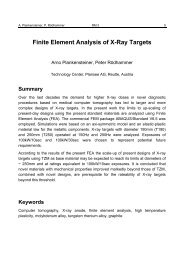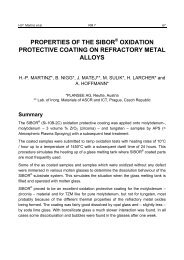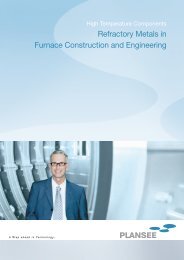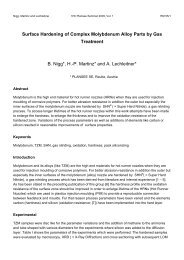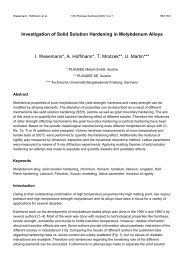P/M Processing of ODS Cr- and Fecr-based alloys for Solid Oxide ...
P/M Processing of ODS Cr- and Fecr-based alloys for Solid Oxide ...
P/M Processing of ODS Cr- and Fecr-based alloys for Solid Oxide ...
You also want an ePaper? Increase the reach of your titles
YUMPU automatically turns print PDFs into web optimized ePapers that Google loves.
A. Venskutonis et al. RM 56 537<br />
Furthermore, P/M processing <strong>of</strong> <strong>ODS</strong> Fe<strong>Cr</strong> pre-alloyed powders enables the<br />
preparation <strong>of</strong> metallic porous substrates which are applicable to metal supported cell<br />
concepts <strong>of</strong> intermediate temperature SOFCs (Fig. 3) [8].<br />
Fig. 3 Morphology <strong>of</strong> a metallic porous P/M substrate <strong>based</strong> on a Fe<strong>Cr</strong>-alloy (left) <strong>and</strong><br />
example <strong>of</strong> foil material processed from P/M Fe<strong>Cr</strong>-alloy (right).<br />
3. Experimental<br />
The different P/M manufacturing routes illustrated in Fig. 1 depend on carefully pretreated<br />
<strong>and</strong> pre-alloyed powders in order to achieve an adequate processing behavior<br />
within the specific manufacturing technology <strong>and</strong> adequate component properties. In<br />
regard to metallic SOFC interconnects, PLANSEE utilizes two different P/M alloy<br />
technologies which both feature an oxide dispersion strengthening (<strong>ODS</strong>) effect. On<br />
the one h<strong>and</strong>, <strong>Cr</strong>-<strong>based</strong> alloy <strong>Cr</strong>-5Fe-1Y2O3 <strong>for</strong> temperatures above 850 o C, on the<br />
other h<strong>and</strong> ferritic Fe<strong>Cr</strong>-<strong>based</strong> <strong>alloys</strong> which are modified by Mo, Ti, Mn <strong>and</strong><br />
miscellaenous alloying additions <strong>for</strong> temperature up to 850 o C. This in order to comply<br />
with all main physical <strong>and</strong> chemical requirements <strong>of</strong> a SOFC interconnect. Main<br />
emphasis on the development <strong>of</strong> Fe<strong>Cr</strong>-<strong>alloys</strong> was laid on improved corrosion<br />
properties in intermediate temperature SOFC relevant atmospheres compared to<br />
ferritic steels including the <strong>for</strong>mation <strong>of</strong> thin <strong>and</strong> well adherent corrosion scales with<br />
excellent contact resistance characteristics. As reference <strong>alloys</strong> in terms <strong>of</strong> property<br />
investigation, three commercially available ingot metallurgical (I/M) processed ferritic<br />
steels, ZMG 232 (trademark <strong>of</strong> Hitachi Metals), <strong>Cr</strong><strong>of</strong>er 22 APU (trademark <strong>of</strong> Thyssen<br />
Krupp VDM) <strong>and</strong> steel 446 were chosen <strong>for</strong> comparison.


